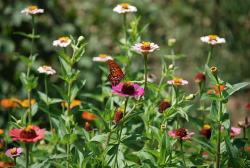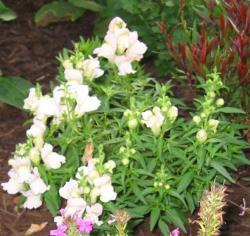My first memory of "gardening" was in kindergarten, when we saved the milk carton we got in school, cut the top off, and planted a marigold to give to "Mom" on Mother's Day.
Now, I don't really remember putting any soil in the carton, or even planting the seed, but I remember that little flower that I grew!
My mother always had flowers in beds around the house. Old-fashioned flowers, nothing fancy. Perennials with annuals sprinkled amongst them. To this day one of her favorites is portulaca, but I only knew it by the name "moss rose." I loved the succulent-looking leaves and the way the center would pop after it was finished blossoming and burst with seeds, falling to the ground to volunteer next summer. There was always something magical about the "volunteers."
I really didn't know much about Latin names or how to grow anything. I just loved the flowers, and after I moved away from home, I started planting my own. At first I just bought six-packs of annuals at the local hardware store, but being the frugal person I am, I quickly figured out I could grow a lot more if I started them from seed myself! So began my seed starting adventure.
For any beginner, starting with the "easy" seeds will give you a sense of success without having to fiddle with stratification, scarification, or any other complicated process just to get a seed to germinate. I would recommend the marigold, but also zinnias, snapdragons, and alyssum.
Marigolds come in all sizes and in quite a variety of golds and reds and even white. They can be large full flowers or small single flowers. Some people don't like the scent of marigolds, but I always have. The strong scent is what also makes them useful for companion planting to help keep the bad bugs away. Many people plant them with their vegetables for this reason. Marigolds are quick to germinate and grow quickly. They can be planted directly in the garden after the last frost. Once your marigolds start to blossom, they will continue to blossom until the first frost. Although they are not often thought of as a good cut flower because of their scent, I have used them in bouquets on occasion. They are a great flower to fill in when all the other flowers start to fade, and to add spots of bright gold to a bed. And if you leave them until frost, some of the seed heads will have dropped to the ground, and you will get some of those wonderful "volunteers" the following year. One seed head can produce over 50 new plants! All you'll have to do is transplant them.

Zinnias are an old favorite of almost everyone. Easy to grow and blooming until frost, they are excellent for borders and make great cut flowers. Zinnias have a tendency toward mildew, so it's important to not plant them too closely. Some of the taller varieties will also benefit from staking. Zinnias will reward you with lots of flowers if you keep the spent flowers cut. Just remember to leave a few to fall to the ground and a few to collect later in the season. There are many new varieties of zinnias to choose from, including dwarfs, spider-shaped petals, greens, striped or speckled, even tri-colored ones. Some of them will be hybrids, so they will not come true from seed, but it's fun to let a few seed heads drop for volunteers and see what interesting variations grow from these hybrids.


Making a snapdragon "snap" was a favorite thing for us to do when we were kids. Snapdragon seeds are very tiny so it will be nearly impossible to plant just one seed where you want it. Not to worry: You can just pinch the extras off at the soil line and keep the biggest one, or you can try to gently transplant the extras. Snapdragons like cooler weather, so you will have to get them in early if you expect many blossoms before the summer's heat. You can also start them in pots inside about 6 weeks before your last frost and then just transplant them to where you want them. Snapdragons do not like to become rootbound, so you need to plant them out before they get too big. They may just sit without many blossoms during the hot summer months, but they will bounce back as soon as it starts to cool off again. There are short varieties for the front of borders, and the taller varieties make excellent cut flowers. Snapdragons will also reseed freely. In milder climates, your snapdragons may even survive a winter, especially if they have some protection.
Alyssum is an all-time favorite of mine because of its rich scent, the low-growing carpet of flowers, and its self-sowing habit! A packet of seed usually contains more than you will ever possibly need for one year, so you can sprinkle them freely and just gently rake them into the soil after the last frost. They germinate quickly, and before long you will have a carpet of sweetly scented flowers. White "Carpet of Snow" is the most popular alyssum, but there are many new colors in shades of reds and purples. If the plants become leggy, just trim them back and they will reward you with another flush of flowers. Alyssum will also blossom into the fall, sometimes even surviving a light frost. You probably won't see the seeds on them, but they will fall and reseed for next year as well. Alyssum will be one of the earliest of the volunteers to germinate.
I have come a long way since first starting with these flower seeds and I still have a lot to learn, but I still cherish planting them every year and looking for my "volunteers" each spring.



